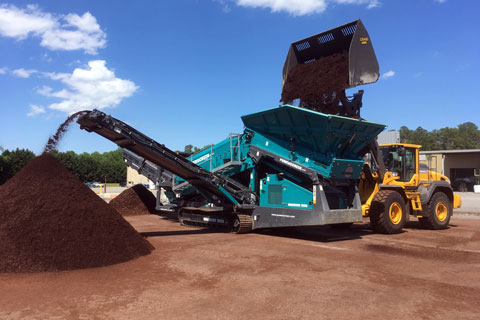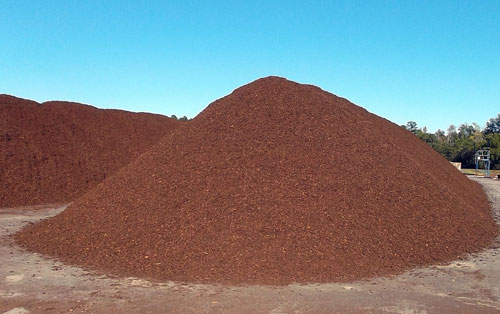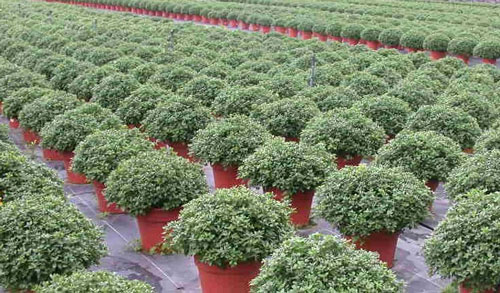8/1/2022
What’s in Your Bark-Based Growing Media?
JoAnn Peery

Bark-based growing media has been a staple in greenhouse crop production for more than 30 years. It’s used primarily for large containers for greenhouse crops, as well as perennial and nursery crops. The key benefits to using bark-based growing media are low water-holding capacity, which reduces the potential for over-watering, coupled with the high bulk density, which serves to increase the stability of the container. In other words, when crops are grown outside the greenhouse the added weight of a bark-based growing media can reduce the chances of the container toppling in high wind and reduce overwatering during periods of heavy rain.
Not all bark is created equal. Hardwood bark from oak, maple and cherry tend to have high levels of toxins that can negatively affect plant growth and tend to decompose rapidly, thus tying up large amounts of nitrogen in the process. The preferred bark source is from a softwood species such as pine, cedar, cypress and spruce. These softwood species have fewer plant toxins and decompose more slowly while using less nitrogen.
 Pictured: Partially composted, cured pine bark is screened to a uniform particle size prior to adding to growing media.
Pictured: Partially composted, cured pine bark is screened to a uniform particle size prior to adding to growing media.
According to the U.S. Forestry Service, much of the available timberland in the U.S. comes from the southern region of the country. Unlike most of the timberland in the western U.S., which is located on government land, more than 80% of the timberland in the southern states is located on private land with fewer restrictions on harvesting. Therefore, most bark-based growing media sold in the U.S. is manufactured using partially composted or aged southern pine bark. There’s some growing media that use northern softwood species.
Composting process
The raw bark used in growing media is a by-product from the lumber industry with its price and availability closely tied to new home construction. The process used to remove the bark from the tree varies based on both the species of tree and equipment used to remove the bark. However, no matter how the bark is removed, the pieces will be larger than optimal for use in growing media, requiring commercial bark producers to hammermill the bark to a more desirable size.
Once the bark has been hammermilled, it goes through a composting and aging process, which breaks down toxins and stabilizes the bark for use in growing media. A fully composted bark would result in a total breakdown of particles and would wind up resembling topsoil. To prevent that, the composting process is halted to prevent total decomposition of the bark, resulting in the desired particle characteristics.
The composting process requires water, carbon and nitrogen so that bacteria in the bark can break down the lipids and proteins in the bark. This process produces heat that can easily reach the 105 to 165F range. When processing bark, the challenge is to avoid high temperatures since there can be a potential for spontaneous combustion. This requires daily temperature monitoring and turning of the bark pile to increase oxygen and add water to the system.
 Pictured: Once screened and graded, partially composted pine bark is stored in windrows prior to blending growing media. Piles are closely monitored and used within days of grading to avoid heating, which can impact the quality of the blended growing medium.
Pictured: Once screened and graded, partially composted pine bark is stored in windrows prior to blending growing media. Piles are closely monitored and used within days of grading to avoid heating, which can impact the quality of the blended growing medium.
The high temperatures produced during the composting process have the added benefit of killing any weed seed or disease contaminants that may be in the bark. The composting process takes anywhere from three weeks to eight months, depending on tree species used, ambient temperature and seasonality of the processing region. The general rule is that the higher the ambient air temperature, the faster the composting process occurs.
Once the composting process has reached the desired level, the process needs to be halted and the bark needs to be cured before it can be incorporated into growing media. The process is stopped by compacting the bark pile with a bucket loader to deplete the oxygen levels, which serves to kill off the microbial organisms that are breaking down the bark.
Characteristics of composted bark
The composting and aging process impacts several physical and chemical properties of the bark. Raw bark is hydrophobic and very acidic (pH of 3.8 to 4.4). The composting process breaks down wax that repels water, which increases the water absorption ability of the bark while increasing the pH. The process also stabilizes the C:N ratio and particle size.
Hammermilling the raw bark before the composting process helps to create a more uniform product in the end, but the bark still needs to be graded before it’s incorporated into growing media. The most common particle size for greenhouse crops is a diameter range between 3/8 and 3/4 inch although nursery stock production will often include larger particle sizes. The grading process is achieved by screening; any oversized bark is sent back to the composting process, while undersized particles can be used in other applications. The finished bark should have an EC of less than 0.5 mmhos/cm2 and a pH between 4.7 and 5.2.
Quality bark-based mixes
Correctly composted bark makes an excellent growing medium component, but without proper management of the composting process it can result in poor-quality product. The proportion of bark to other components in the growing medium can vary greatly depending on the container size, crop grown and watering practices. The higher the percentage of bark, the less water-holding capacity the mix will have and the higher the bulk density of the growing medium.
 Pictured: Garden mums and perennials are commonly grown in bark-based growing media for the low water retention, good drainage and high bulk density characteristics, particularly when outdoor crops are subjected to rainy weather and high winds.
Pictured: Garden mums and perennials are commonly grown in bark-based growing media for the low water retention, good drainage and high bulk density characteristics, particularly when outdoor crops are subjected to rainy weather and high winds.
As stated earlier, bark-based growing media is primarily used for large container greenhouse crops, perennials and nursery production. Depending on particle size, it can be used in cell pack production, but isn’t recommended for plug production. The high bulk density of bark-based mixes can limit shipping from the manufacturing location, since product weight reduces the number of bags/pallets of material shipped on a truck. The coarse nature of bark mixes also prohibits its ability to be compressed and baled like peat-based mixes.
Premier Tech Horticulture produces bark-based growing media with varying amounts of bark, peat moss and perlite. PRO-MIX formulations are available with the added benefit of BIOFUNGICIDE and MYCORRHIZAE. BIOFUNGICIDE (Bacillus pumilus PTB180) creates a biofilm around plant roots that provides protection against damping-off, and crown and root rot diseases caused by Pythium, Rhizoctonia and Fusarium, as well as provides some insect suppression from fungus gnats and thrips. MYCORRHIZAE (Glomus intraradices PTB297) colonizes the plant root system and forms an extension of plant roots for better access to nutrients and water for increased uptake. This results in better plant growth, increased stamina and improved tolerance to environmental stresses. GT
JoAnn Peery is a Horticulture Specialist—Central Region for Premier Tech Growers & Consumers.